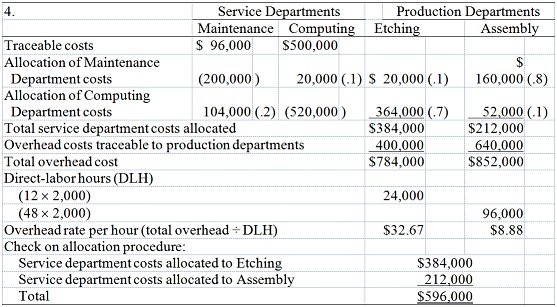Crystal Magic Company is developing departmental overhead rates based on direct-labor hours for its two production departments in the production of light-catcher art pieces, Etching and Assembly. The Etching Department employs 12 people and the Assembly Department employs 48 people. Each person in these two departments works 2,000 hours per year. The production-related overhead costs for the Etching Department are budgeted at $400,000, and the Assembly Department costs are budgeted at $640,000. Two service departments, Maintenance and Computing, directly support the two production departments. These service departments have budgeted costs of $96,000 and $500,000, respectively. The production departments' overhead rates cannot be determined until the service departments' costs are
allocated. The following schedule reflects the use of the Maintenance Department's and Computing Department's output by the various departments.
Using Department Service Department Maintenance Computing Etching Assembly Maintenance (maintenance hours) 0 1,000 1,000 8,000 Computing (minutes)240,000 0 840,000 120,000 Required:(Use M for Maintenance and C for Computing in your equations.)1. What is the equation for the total cost of the maintenance department when using the reciprocal services method? 2. What is the equation for the total cost of the computing department when using the reciprocal services method?3. Solve each equation.4. Using the reciprocal-services method to allocate service department costs, calculate the overhead rates per direct-labor hour for the Etching Department and the Assembly Department.
What will be an ideal response?
1. Reciprocal-services method: Equations for Maintenance: M = 96,000 + .2C
2. Reciprocal-services method: Equations for Computing: C = 500,000 + .1M
3. Solution of equations:
M = 96,000 + .2 (500,000 + .1M)
M = 96,000 + 100,000 + .02M
.98 M = 196,000
M = 200,000
C = 500,000 + .1 (200,000)
C = 520,000

You might also like to view...
Which of the following refers to change along the technology innovation curve that allows for the development of products that are less expensive, smaller, and often easier to use?
A) discontinuous innovation B) disruptive innovation C) continuous innovation D) end-user innovation E) radical innovation
How does the current version of Title VII of the Civil Rights Act of 1964 differ from the legislation as it was originally passed?
a. It protects against discrimination based on religion. b. It is more restricted in its definition of “protected class.” c. It is not enforced as well. d. It protects against discrimination based on age.
Overproduction______.
A. contributes to unnecessary inventory B. contributes to shorter lead times C. is an example of eagerness to serve the market D. supports the idea of sustainability
Which of the following is an incorrect statement regarding the scope of the UCITA?
A) The UCITA deals only with information that is electronically disseminated. B) Under the UCITA, a computer information transaction is an agreement to create, transfer, or license computer information. C) Few provisions of the UCITA are similar to Article 2 of the UCC. D) Under the UCITA, a licensing agreement may be interpreted by the courts using the express terms of the agreement, as well as course of performance and usage.